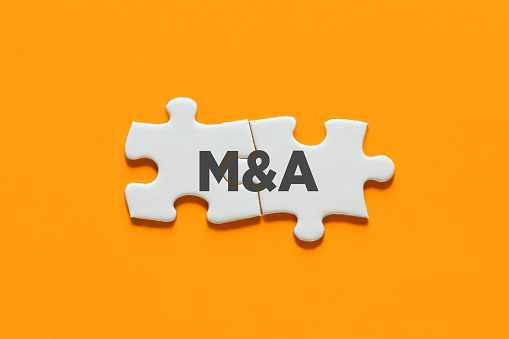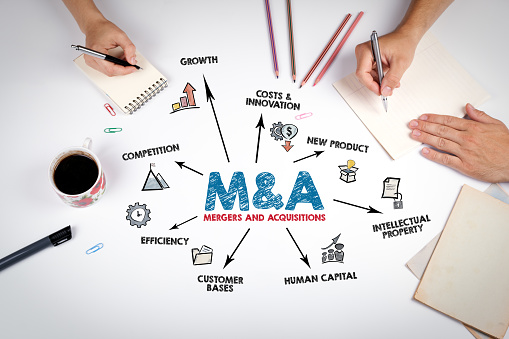M&A Synergies
Refers to the value created after the combination of two firms. This value can be either in the form of cost reduction or revenue growth
There are various ways companies combine to explore partnerships. In corporate finance, mergers and acquisitions (M&A) are deals between two or more companies to come together as one entity to increase their business and reduce costs.

There can be other various strategic reasons as well. The concept of synergy drives the combination of two or more companies. This can be in the form of higher profits.
M&A helps the involved firms to reduce competition, enter new markets, cut down employee costs, etc. These factors can provide competitive advantages to the merged entity, helping them outperform peer companies.
Since the term comprises two words, let us first understand their difference. As we saw above, mergers and acquisitions are ways of combining two or more companies. Depending on the interests of the concerned firms and their businesses, a merger or acquisition can occur.
A merger occurs when two firms merge to form a new company with one combined stock. On the other hand, an acquisition is the takeover or purchase of a company by another business entity.
Mergers mostly take place to reduce competition and increase efficiency, while acquisitions are made to enter new markets or boost growth in existing ones. In the case of acquisition, companies don’t lose their existence since no new company is formed.
Examples: Merger -> Heinz and Kraft merger in 2016
Talks for a merger between Heinz and Kraft started in the year 2015. The major investors took up 51% stake, and the rest, 49%, was available for other shareholders. These shareholders received dividends from the investors. Here are more details.
Acquisition -> Verizon acquired majority stakes in Vodafone
After the acquisition of Vodafone by Verizon, Verizon issued around 1.2 billion shares to the shareholders of Vodafone. Verizon gathered the transaction amount through Term Loan Credit and capital market transactions. Click here for more details.
Apart from the reasons mentioned above, there might be a plethora of strategic reasons behind a merger. Let us have a look at some of them here:
- Expand their business in other sectors, grow revenue, diversify or minimize risk, cost optimization, achieve economies of scale, and increase their market share.
- Various ways through which companies merge are horizontal mergers, vertical mergers, congeneric mergers, and conglomerate mergers.
- A horizontal merger is done between companies competing in the same industry segment.
- A vertical merger is done when two companies are in the same field but are in different steps/processes of the value chain.
- In the case of a co-generic merger, the concerned companies have commonalities in the target audience or the associated technology in business.
Relative to a merger, acquiring require more resources

- One of the most important reasons is improving their market share stand. Similar to a merger, the acquisition allows companies to enter a new market segment.
- There are various ways a company can acquire other companies. For example, takeovers can either be hostile or be done with mutual understanding and interaction between two business entities.
The other types of acquisitions are backflip acquisition and reverse acquisition. Let us understand what backflip acquisition and reverse acquisition mean in terms of the takeover.
In the case of backflip acquisition, the acquired company becomes the parent company.
The reverse acquisition takes place when a private company takes over a listed company.
A merger is a more common form of transaction. It has some advantages over acquisitions.
- It doesn’t require any money transaction as no company is buying the other. Most of the merger negotiation goes into deciding the share of each business entity in the new organization.
- A merger usually benefits both the parent companies as it reduces costs, improves profits, and there is no hostile takeover.
Synergy in M&A
Synergy, as the word suggests, is the additional value created from a transaction in case of an M&A deal. The value addition leads to the value of the new entity is greater than the sum of the individual entities. Therefore, synergies are a way to justify an M&A deal.

Most of these objectives are to lead to adding a new product line or adding scale through a bolt-on acquisition, i.e., either vertical or horizontal growth.
These can be in various forms; we will take a look at the types below. The types are based on the various output factors that can be improved.
These are broadly divided into the following four categories in M&A transactions to consider:
- Revenue Synergy
- Cost Synergy
- Financial Synergy
- Market Synergy
Let us understand them along with some relevant examples.
What is revenue synergy?
It is the most common reason for M&A. As the name suggests, these are based on the assumption that the combined companies can generate more cash flows than if their cash flows were added together. It is highly time-consuming to realize and capture, taking considerably more time than cost synergies.

It involves developing appropriate targets and executing new workflow and sales strategies across all functions. Revenue synergy can be understood as economies of scope as it increases products, customers, etc.
It can be achieved in the following ways. However, the points mentioned below are not exhaustive since many other ways exist to achieve the same. It is important to understand the sources of revenue synergies.
- Cross-selling
- Reduction of competition
- Access to new markets
What is cost synergy?
Cost synergy, as the name suggests, focuses on cost reduction. Let us understand with the help of an example.
During a merger or acquisition, there is a possibility of excess resources, like two HR departments, which can be reduced, hence the name - cost synergy. So it is more like a back-office value addition process.
This can be understood in economies of scale as it reduces cost and increases production.

The ways Cost synergy works are below:
- Marketing strategies and channels: There is an increase in marketing and PR channels, and resources may result in reduced costs.
- Shared information and resources: Increase in research and development can lead to increased IPs, advanced technology, etc., hence cost savings.
- Reduction in salaries: This can be understood from the above-mentioned example of two HR departments. Lay-offs will reduce the fixed employee cost, thus improving the company’s financials.
- Streamlined processes: There will be an increase in the company’s efficiency in ways such as streamlining processes, supply chains, technology, etc.
Calculating operating cost synergy can be done as they have a fixed quantitative value.
What is Financial Synergy?
It focuses on the betterment of financial activities and conditions. This involves:
- a strengthened balance sheet,
- a lower cost of capital,
- tax benefits, and
- easier access for the combined firm to capital.

What is Market Synergy?
These are the collaboration ways that result in a higher market presence. This leads to an increase in negotiation power. For example, if two companies have merged, their production has increased, and now because of higher demand, they have the power to bargain with stakeholders.
Synergy Realization
There have been many failed M&A over the years.
For example, Daimler-Benz and Chrysler. This one is a peculiar example. It not only focuses on the quantitative side but also considers other factors. It is believed that this M&A’s failure was inevitable because of the cultural differences between the two companies.
Many other examples led to failure due to valuation issues.

Let us look at various gains possible in Revenue and Cost synergies.
- Efficiency gains - increase in efficiency can be justified using economies of scale and economies of scope.
- Entry speed gains - An increase in entry speed can be understood from the fact that the acquired or merged company already has access to the market. As we know, retaining a customer is cheaper in terms of time and money, and there is an entry speed gain in M&A.
- Competitive gains - M&A deals help to enter newer markets with already acquired customers. In some cases, markets are saturated with already established competition, and entering such a market without any M&A transaction will be very expensive.
- Resource gains - In many sectors, such as the tech sector, there are many patents/IPs in the market which cannot be acquired unless there is an M&A deal.
- Gains of resource sharing - Similar to reducing the workforce, many resources such as machines for administrative purposes will be reduced, hence the gains.
- Bargaining power gains - As expected, with the increase in volume, their bargaining power with different stakeholders increases.
Analysis
Many questions need to be answered from a company’s perspective that is trying to delve into a merger and acquisition deal(from a synergies’ point of view).
The first and foremost is what criteria organizations plan to utilize to evaluate a potential M&A deal. Then we need to understand which of them are predominant and how they will affect the future of the concerned companies. The last is what are the most important factors for the deal.

Let us have a look at Qualitative methods to answer the above questions. The four words to evaluate a deal are what, why, where, and how.
Qualitative analysis gives answers to the following questions:
- What are the possible collaborative outcomes from the given Merger and Acquisition transaction?
- Different types of M&A strategies can take place, so the question is why a certain strategy would be chosen.
- How are they created, and where are they found
Quantitative valuation(Analysis) might not be accurate, and the collaborative results might underperform. Evaluating the value generated from a deal is a very complex process. As a result, there is always a high possibility of overestimating the value generated in the transaction process.
There is always a possibility of Negative synergies. Most of these have outcomes greater than the sum of individual inputs (companies); there are some ways in which the outcome becomes less than the sum of individual companies. This is called negative synergy, i.e., 1+1<2.
To understand the negative aspects, we need to understand the concepts of the diseconomies of scale and diseconomies of scope.

What we mean by diseconomies of scale is that when a company expands beyond a limit, its cost of production per unit increases. It can be due to various reasons, such as lack of management and coordination.
The level of bureaucracy increases with M&A deals. This leads to an increase in lead times and administrative work. Arising issues can be classified into two types - the contagion effect and the capacity effect.
Contagion and capacity effects are paradoxes of synergy. Both of them are related and yet very different.
- The contagion effect arises from the interdependency of combined companies. There are various ways of sharing resources that can bring a negative impact on the performance of the workforce.
Sharing between companies, such as incompetency at the management level, can reduce efficiency and increase the attrition rate. - While in the case of the capacity effect, there is a possibility that the combined firm has a limited number of resources, and using them for an extended period can increase stress on the company’s resources.
There are some capacity constraints associated with resources such as the workforce. For example, as two companies merge, many employees are laid off to increase the company’s efficiency.
Since the output to be produced has increased, but the number of employees is decreased, there is a lot of workload on the current employees.
Integration Phase
The integration phase of the Merger and Acquisition deal is the last phase of an M&A deal. This is when the synergies are realized.

There are four possible ways to integrate companies. These ways are dictated by the need for autonomy in the company and the level of integration. The four possible ways are Conservative, Symbiosis, Absorption, and Holding.
- Conservative strategy: It is a recommended way for companies with a high need for autonomy and low need for integration
- Symbiosis strategy: It is a recommended way for companies with a high need for autonomy and a high need for integration
- Absorption strategy: It is a recommended way for companies with a low need for autonomy and a high need for integration
- Holding strategy: It is recommended for companies with a low need for autonomy and a low need for integration. Because of the low need for autonomy and integration, it doesn’t need any integration.
As we saw above, timing can lead to a difference in the expected synergies. The importance of timing depends on the type of integration applied in the deal. Several day-one issues can depreciate the expected synergies if not resolved quickly.

So, for a smooth transition, the company makes sure to stay focused on the day-to-day activities, such as sales and customer service, that are not hampered in the initial days before planning to widen improvements across the firm.
With synergies, there are a few challenges that need to be overcome. Let us look at these possible problems to avoid:
- When it is not defined clearly, making sure that its execution takes place is a challenge. Management executives must ensure that things are implemented and follow up regularly.
- Synergies are time-sensitive. The effect of possible outcomes declines significantly as time passes after deal closure. Therefore, the firm needs to make sure synergies are executed as soon as possible.
- Incentivization is required for realizing synergies. However, there have been reports where firms don’t use sufficient incentives, thus leading to losing synergies.
- Many a time, firms are overloaded with keeping up with the pace of work, sales, operations, etc. So, management tries to implement synergies by themselves and doesn’t involve the employees. This leads to the execution part being less efficient.
- There have been mismatches in the culture of the companies involved. For example, the Merger of Chrysler and Daimler-Benz was one of the biggest failures because of differences in companies’ cultures and visions.
Summary:
- Synergy is the additional value created from a transaction in case of an M&A deal.
- Broad classification - Revenue Synergy, Cost Synergy, Financial Synergy, and Market Synergy
- Qualitative questions for Synergy Analysis -
- What are the possible collaborative outcomes from the given Merger and Acquisition transaction?
- Different types of M&A strategies can take place, so the question is why a certain strategy would be chosen.
- How are they created, and where are they found
- During the integration stage, we come across four possible strategies of merging depending on the need for autonomy and the need for integration.




or Want to Sign up with your social account?